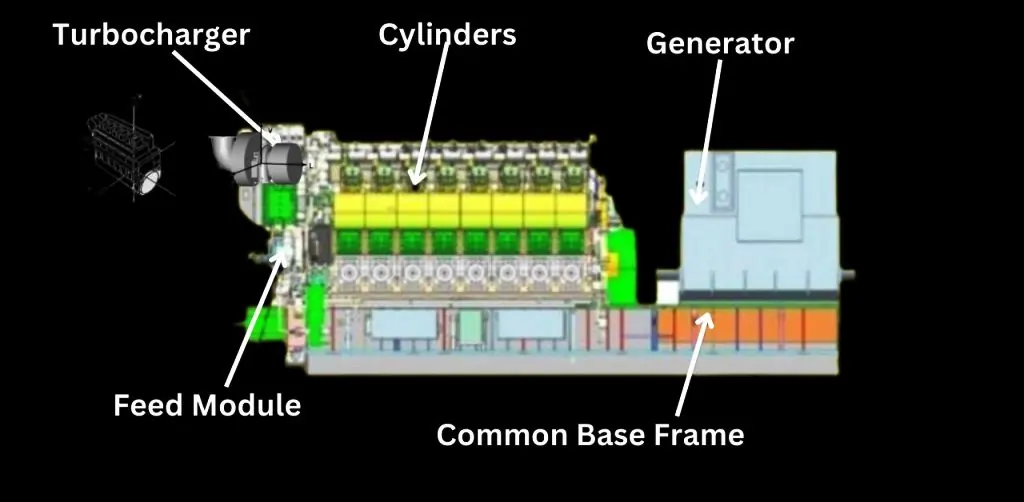Boat Motor Vibration
Boat motors are among the most widely used machines globally, playing crucial roles in various industries, including marine, power generation, transport, heating and cooling, and agriculture. However, boat motor engines, in particular, produce vibrations that can significantly impact engine performance. These vibrations, though often unnoticed, can lead to serious issues such as instability, noisy emissions, and problems in the fuel system.
In this blog post, we will delve into the various vibrations that can occur in boat motor engines. Our goal is to help you understand the different types of vibrations, the dangers they pose, and how to avoid them. We will cover essential guidelines for managing vibrations, discuss how to measure them, and explain acceptable vibration levels for boat motor engines. Additionally, we will explore the associated electrical and mechanical components of these engines and provide insights based on my 45 years of experience working with marine and industrial engines.
This post will form a foundation for understanding the theoretical aspects of vibrations and the standard techniques used to manage them. Given the numerous vibration standards and the lack of specific guidelines for engine-mounted components, we will reference the knowledge of my colleagues and my extensive experience to establish useful guidelines for managing vibrations in boat motor engines.
By the end of this post, you will know the following:
- Essential guidelines for managing vibrations in boat motor engines.
- Types of vibrations and how to measure them.
- Acceptable levels of vibrations.
- Placement of sensors for measuring vibration readings.
- Interpretation of vibration results.
What are Vibrations in Boat Motor Engines?
Vibrations in boat motor engines refer to the oscillatory motions or mechanical movements that occur within the engine’s components during operation. These vibrations result from various dynamic forces and imbalances in the engine system, which can affect the engine’s performance, longevity, and overall efficiency.
Causes of Vibrations in Boat Motor Engines
- Imbalanced Rotating Components: Components such as the crankshaft, pistons, and propeller can become imbalanced due to wear and tear, improper installation, or manufacturing defects, leading to uneven forces and vibrations.
- Misalignment: Misalignment of the engine with the drive shaft or other components can create significant vibrations. Proper alignment is crucial for smooth operation.
- Wear and Tear: Over time, engine components like bearings, mounts, and couplings can wear out, leading to increased play and vibrations.
- Combustion Irregularities: Inconsistent combustion within the cylinders can create uneven forces, resulting in vibrations. This can be due to issues such as poor fuel quality, injector problems, or ignition issues.
- Structural Resonance: Every engine has a natural frequency. If the operational frequency matches the natural frequency, it can cause resonant vibrations, amplifying the oscillations.
- Exhaust System Issues: Problems in the exhaust system, such as blockages or leaks, can alter the backpressure and create vibrations.
Effects of Vibrations
- Performance Degradation: Excessive vibrations can lead to inefficient engine performance, reducing power output and fuel efficiency.
- Component Damage: Continuous vibrations can cause fatigue and eventual failure of engine components, leading to costly repairs and downtime.
- Noise: Vibrations often result in increased noise levels, which can be a nuisance and indicate underlying issues that need addressing.
- Instability: Vibrations can make the engine unstable, affecting the overall stability of the boat and potentially leading to safety hazards.
Measurement and Mitigation
- Sensor Placement: Installing vibration sensors at critical points on the engine can help monitor vibration levels in real-time.
- Regular Maintenance: Routine checks and maintenance can identify and rectify sources of vibrations, such as worn-out parts or misalignments.
- Balancing: Ensuring all rotating components are properly balanced can significantly reduce vibrations.
- Alignment Checks: Regularly checking and correcting the alignment of the engine with the drive shaft and other components helps minimize vibrations.
- Damping Systems: Using vibration dampers and isolators can help absorb and reduce vibrations, protecting the engine and associated components.
Types of Vibrations
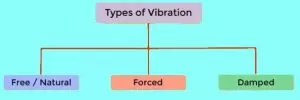
Types of Vibrations in Boat Motor Engines
During the operation of a boat motor engine, various types of excitations create vibrations. Due to the engine’s rotating parts, firing, and gas pressure, achieving complete control of these vibrations is impossible. The complex design of marine diesel engines makes it challenging to prevent vibrations from approaching the engine’s natural frequency, which can lead to higher forces and catastrophic failures. Different engine parts will exhibit varying vibration levels, necessitating thorough checks across various points and directions along the longitudinal, transversal, and vertical axes. Below are the key types of vibrations encountered in boat motor engines:
1. Vibration in an Engine
Engine vibrations stem from multiple sources, including rotating components, combustion irregularities, and structural resonances. These vibrations can affect engine performance, longevity, and safety. It is crucial to monitor and control vibrations to prevent potential damage and ensure smooth operation.
2. Free Vibration
Definition: Free vibration occurs when an engine or its components are displaced from their equilibrium position and allowed to vibrate without external forces acting upon them.
Characteristics:
- Natural Frequency: The engine vibrates at its natural frequency, determined by its mass and stiffness.
- Decay Over Time: The vibration amplitude decreases gradually due to inherent damping properties within the engine materials.
Example: A crankshaft experiencing free vibration after a sudden displacement from its rest position.
3. Forced Vibration
Definition: Forced vibration occurs when an external force continuously drives the engine or its components at a specific frequency.
Characteristics:
- Resonance Risk: If the forcing frequency matches the engine’s natural frequency, resonance occurs, amplifying the vibration amplitude significantly.
- Continuous Input: The external force can come from imbalances, misalignments, or periodic forces within the engine.
Example: Vibrations caused by unbalanced rotating components or misaligned drive shafts.
4. Damped Vibration
Definition: Damped vibration is a type of vibration where energy is gradually lost over time, reducing the vibration amplitude due to the presence of damping mechanisms.
Characteristics:
- Energy Dissipation: Damping materials or systems absorb vibrational energy, converting it to heat or other forms.
- Controlled Amplitude: The damping effect helps control and reduce the vibration amplitude, preventing potential damage.
Example: Engine mounts designed to absorb and dissipate vibrational energy, reducing overall engine vibrations.
Monitoring and Control
Vibration Checks
To manage and control engine vibrations, it is essential to conduct vibration checks at various points and in different directions (longitudinal, transversal, and vertical axes). This comprehensive monitoring helps identify areas with excessive vibrations that require attention.
Normal Readings
The obtained vibration readings should fall within the prescribed normal limits for each direction. If the measurements exceed these limits, thorough investigations, checks, and corrective actions are necessary.
Key Formulas for Understanding Vibrations in Boat Motor Engines
To further enhance the understanding of vibrations in boat motor engines, it is useful to include relevant formulas. These formulas help in quantifying vibrations, analyzing their effects, and implementing control measures.
1. Natural Frequency
The natural frequency of a vibrating system is a crucial parameter. It can be calculated using the formula:
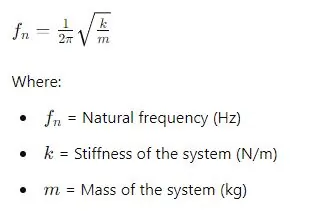
2. Damped Natural Frequency
When damping is present, the natural frequency is modified. The damped natural frequency is given by:
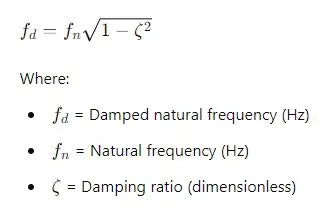
3. Damping Ratio
The damping ratio (ζ) is a dimensionless measure of damping, which can be calculated as:
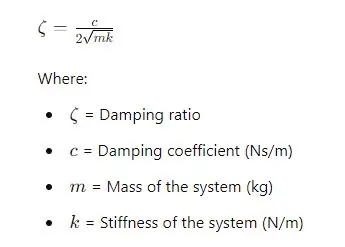
4. Forced Vibration Response
The response amplitude of a system subjected to forced vibration is given by:
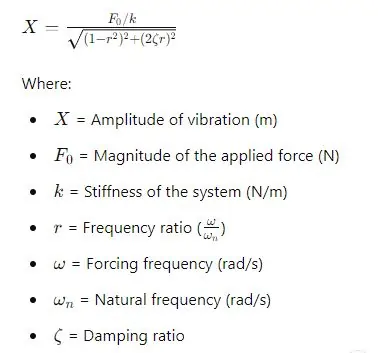
5. Transmissibility
Transmissibility (T) is a measure of how much vibration is transmitted through a system and is given by:
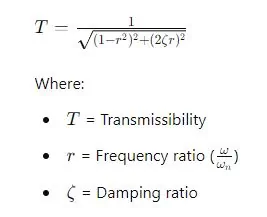
6. Resonance
At resonance (when r=1r = 1r=1), the amplitude of the forced vibration is maximized. The resonance condition occurs when:
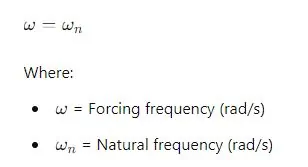
7. Energy Dissipation in Damped Systems
The energy dissipated per cycle in a damped system can be calculated using:
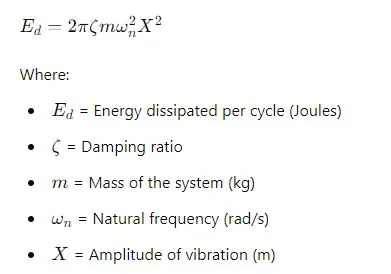
Practical Application of Formulas
Vibration Checks
To carry out effective vibration checks at various points and directions in the longitudinal, transversal, and vertical axes, these formulas help in:
- Identifying Natural Frequencies: Calculate the natural and damped natural frequencies to determine the resonance conditions.
- Evaluating Damping Efficiency: Use the damping ratio to assess how well the system can dissipate vibrational energy.
- Analyzing Forced Vibration Response: Determine the amplitude of vibrations due to external forces and assess the impact of resonant frequencies.
- Measuring Transmissibility: Evaluate how much vibration is transmitted through the engine components and identify areas for improvement.
Natural Frequency: A Detailed Description
Natural frequency is a fundamental concept in the study of vibrations, particularly in mechanical systems like boat motor engines. It is the frequency at which a system tends to oscillate in the absence of any driving or damping force. Understanding natural frequency is crucial for diagnosing and mitigating vibration-related issues in engines.
Definition of Natural Frequency
Natural frequency (fn) is the rate at which an object vibrates when it is disturbed from its equilibrium position and then allowed to vibrate freely. It is determined by the physical properties of the system, including its mass and stiffness.
Mathematical Representation
The natural frequency of a simple mechanical system, such as a mass-spring system, can be calculated using the following formula:
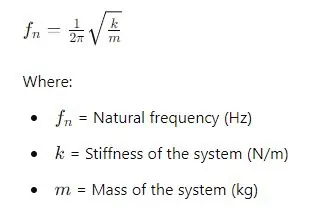
This formula indicates that the natural frequency is directly proportional to the square root of the stiffness and inversely proportional to the square root of the mass.
Importance in Boat Motor Engines
- Vibration Analysis: Knowing the natural frequency of engine components helps in predicting and analyzing vibrations. Components operating at or near their natural frequencies can experience resonant vibrations, which can amplify the oscillations and lead to significant damage.
- Resonance Avoidance: Resonance occurs when the frequency of an external force matches the natural frequency of a system, resulting in maximum energy transfer and large amplitude vibrations. Designing engine components to operate away from their natural frequencies helps avoid resonance and its detrimental effects.
- Maintenance and Diagnostics: Identifying the natural frequencies of various engine components allows for targeted maintenance and diagnostic procedures. If excessive vibrations are detected at certain frequencies, it can indicate that the system is operating near its natural frequency, requiring adjustments or repairs.
Factors Affecting Natural Frequency
- Mass (m): Increasing the mass of a component generally decreases its natural frequency, making it vibrate more slowly. Conversely, reducing the mass increases the natural frequency.
- Stiffness (k): Increasing the stiffness of a component increases its natural frequency, causing it to vibrate more quickly. Decreasing stiffness lowers the natural frequency.
Practical Examples
- Crankshaft Vibration: The crankshaft in a boat motor engine has its own natural frequency. If the operating speed of the engine approaches this frequency, the crankshaft can experience resonant vibrations, leading to excessive wear or failure.
- Engine Mounts: Engine mounts are designed to isolate vibrations from the engine to the boat structure. They must be designed with natural frequencies that are far removed from the engine’s operating frequencies to effectively dampen vibrations.
- Propeller Shafts: Propeller shafts also have natural frequencies that need to be considered. Operating the engine at speeds that induce resonant vibrations in the propeller shaft can cause significant damage to both the shaft and the engine.
Measuring Natural Frequency
Natural frequency can be measured using various techniques:
- Impact Testing: This involves striking the component with a hammer and measuring the resulting vibrations using accelerometers. The dominant frequency in the vibration signal is the natural frequency.
- Modal Analysis: This advanced technique uses multiple sensors and sophisticated software to analyze the vibrational characteristics of a component, identifying its natural frequencies and mode shapes.
Mitigating Natural Frequency Issues
- Design Adjustments: Engineers can modify the design of engine components to shift their natural frequencies away from operating ranges. This can involve changing materials, altering geometries, or adding mass.
- Damping: Introducing damping materials or systems helps reduce the amplitude of vibrations at or near the natural frequency, preventing resonance.
- Operational Changes: Adjusting the operating speed of the engine to avoid resonance frequencies can mitigate vibration issues.
Vibration Measuring Specifications
. Displacement measurement;- is applicable for measuring frequency below 30 Hz and below.
Velocity measurement;- Is suitable for measuring the frequency between 10 -300 HZ.
International Standards
-
ISO 10816-6;- This standard is applicable for engines above 100 KW. As per this standard, the vibration level should be 2 HZ to 1000HZ.
Vibration Measurement Locations (Points)
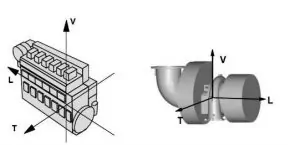
Vibration in marine diesel engine
- Drive end ,
- Engine centre,
- Non-drive end of crankshaft.
Take the measurement at the working temperature ofthe engine..
Measurements
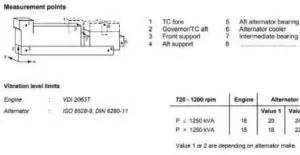
Component directions
The crankshaft will be in the longitudinal direction for the measurement of vibration at the engine.
The turbocharger will be in a longitudinal direction during the measurement of vibration at the turbocharger.
Vibration Damper
Torsional Vibration Damper (spring and oil dashpot type viscous Damper)
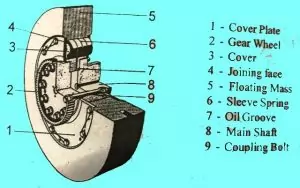
Silicone Damper
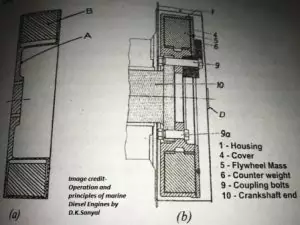
Causes of Vibration
Harms of Vibration in marine diesel engine
Vibration in an engine is most unwanted for the following reasons.
1. Increases stress
2. Addition in wear of parts
3. Increases sound levels
4. Excessive material fatigue
5. Loss in energy
6. Increase in bearing loading.
All the above factors will result in failure and breakdown in an Engine
Remedial action for reducing the Vibration
Vibration due to Defects in Diesel Engines
Improper Tappet Clearance
Maintaining Valve clearance of diesel engines as per the OEM set values is essential. Valve clearance affects combustion and opening and closing of valves. Improper valve clearance will lead to severe defects. Excessive valve clearance will result in the valve’s late start and early closing.
The excessive valve clearance in the inlet valve will result in insufficient air supply to the combustion chamber. Insufficient air for the combustion will cause poor combustion leading to a low compression ratio, less power, improper combustion, less fuel economy after burning, and high carbon deposits inside the combustion chamber.
If an engine continues to run with excessive inlet valve clearance will result in power loss. A piston seizure may occur due to sticky piston rings with high carbon deposits.
Excessive valve clearance in the exhaust valve will lead to poor scavenging followed by knocking, heavy power loss, and high temperatures will lead to catastrophic failure of the Engine. The above phenomenon will severely impact the valve driving mechanism, causing heavy vibrations in the Engine.
Piston Slap
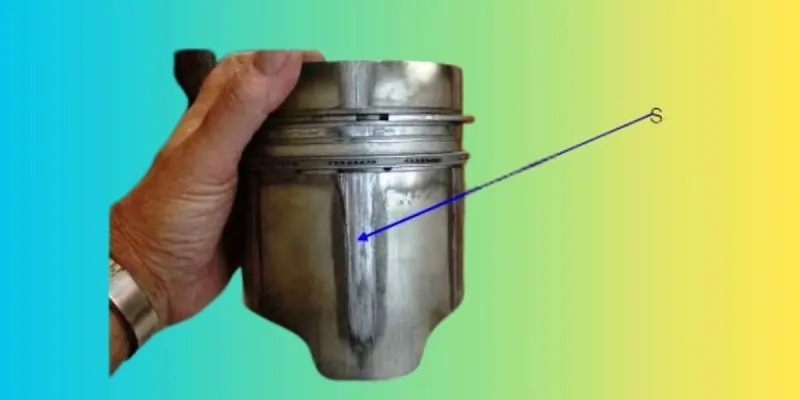
Engine power, reliability, durability, economy, and emissions are highly influenced by the tribological conditions of the cylinder liner and piston rings. The generation of engine noise and piston slap takes place by the piston mechanism. Piston slap is the primary source of transversal vibration in Diesel engines.
Harsh engine conditions are created due to the high piston speed. Under the condition of the boundary lubrication due to the contaminated lubricating oil and high external shock load, metal-to-metal between the piston and cylinder liner will take place. Under such conditions of piston slap, excessive oversized clearances will cause.
Impact forces between the piston and cylinder liner wall increase tremendously due to the excessive clearances accelerating in wear of moving parts. The piston slap and the piston ring clearance are interrelated. The intensity of the piston slap will be the source of high vibration.
Hence OEM recommendations for the measurement of clearances and change of related parts should be strictly adhered to control the Engine’s vibrations, excessive noise, and catastrophic failures.
Faults in the fuel injection system
The fuel injection system is the Engine’s most crucial and controls the Diesel engine’s performance and reliability. The close examination of injection system conditions and fault diagnosis is the base of the fuel injection system function. A defective fuel injection system is responsible for the exhaust system’s power loss and increased pollutants. A higher fuel injection pressure will fuel consumption and increase emissions. A lower fuel injection pressure will decrease the engine power. A defective fuel injection pressure will cause poor fuel metering and poor fuel combustion.
A defective fuel injector will cause power loss due to improper combustion and high exhaust temperatures. Unbalanced power in each cylinder will result in increased engine vibrations.
Blog Conclusion
We hope you enjoyed our blog about Vibration in the marine diesel engine. With the help of this blog piece, we hope that you will be able to understand the content of Vibration in marine diesel engines and how Vibration in marine diesel engines affects the engine.We are so happy that you found it informative and helpful. If you have any questions about Vibration in marine diesel engines, please don’t hesitate to contact us. We would love to hear from you!
